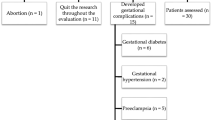Abstract
Objective
To investigate the association between maternal oxidative stress at mid-gestation and subsequent development of pregnancy complications.
Study design
A total of 503 healthy pregnant women provided their blood and urine samples at 24 to 26 weeks of gestation and were prospectively followed through postpartum. These samples were used to assess a variety of oxidative stress markers, including plasma total antioxidant capacity, 8-isoprostane, erythrocyte glutathione peroxidase and superoxide dismutase activity, and urinary 8-hydroxydeoxyguanosine (8-OHdG).
Results
Compared with women with uncomplicated pregnancies, significantly higher plasma 8-isoprostane levels were noted in women who developed preeclampsia (P = .008) and small-for-gestational age infants (P = .002), while higher urinary 8-OHdG concentrations were noted in women who subsequently had low-birth-weight neonates (<2500 g, P = .043).
Conclusion
Increased maternal oxidative stress at mid-gestation was associated with subsequent pregnancy complications.
Similar content being viewed by others
References
Little RE, Gladen BC. Levels of lipid peroxides in uncomplicated pregnancy: a review of the literature. Reprod Toxicol. 1999; 13(5):347–352.
Hung TH, Lo LM, Chiu TH, et al. A longitudinal study of oxidative stress and antioxidant status in women with uncomplicated pregnancies throughout gestation. Reprod Sci. 2010;17(4):401–409.
Toescu V, Nuttall SL, Martin U, Kendall MJ, Dunne F. Oxidative stress and normal pregnancy. Clin Endocrinol (Oxf). 2002;57(5):609–613.
Hubel CA. Oxidative stress in the pathogenesis of preeclampsia. Proc Soc Exp Biol Med. 1999;222(3):222–235.
Chen X, Scholl TO. Oxidative stress: changes in pregnancy and with gestational diabetes mellitus. Curr Diab Rep. 2005;5(4):282–288.
Fainaru O, Almog B, Pinchuk I, Kupferminc MJ, Lichtenberg D, Many A. Active labour is associated with increased oxidisibility of serum lipids ex vivo. BJOG. 2002;109(8):938–941.
Schulpis KH, Lazaropoulou C, Vlachos GD, et al. Maternal-neonatal 8-hydroxy-deoxyguanosine serum concentrations as an index of DNA oxidation in association with the mode of labour and delivery. Acta Obstet Gynecol Scand. 2007;86(3):320–326.
Hung TH, Chen SF, Hsieh TT, Lo LM, Li MJ, Yeh YL. The associations between labor and delivery mode and maternal and placental oxidative stress. Reprod Toxicol. 2011;31(2):144–150.
Chappell LC, Seed PT, Briley A, et al. A longitudinal study of biochemical variables in women at risk of preeclampsia. Am J Obstet Gynecol. 2002;187(1):127–136.
Min J, Park B, Kim YJ, Lee H, Ha E, Park H. Effect of oxidative stress on birth sizes: consideration of window from mid pregnancy to delivery. Placenta. 2009;30(5):418–423.
Parra M, Rodrigo R, Barja P, et al. Screening test for preeclampsia through assessment of uteroplacental blood flow and biochemical markers of oxidative stress and endothelial dysfunction. Am J Obstet Gynecol. 2005;193(4):1486–1491.
Peter Stein T, Scholl TO, Schluter MD, et al. Oxidative stress early in pregnancy and pregnancy outcome. Free Radic Res. 2008;42(10):841–848.
Hsieh WS, Wu HC, Jeng SF, et al. Nationwide singleton birth weight percentiles by gestational age in Taiwan, 1998–2002. Acta Paediatr Taiwan. 2006;47(1):25–33.
Benzie IF, Strain JJ. The ferric reducing ability of plasma (FRAP) as a measure of “antioxidant power”: the FRAP assay. Anal Biochem. 1996;239(1):70–76.
Konishi M, Iwasa M, Araki J, et al. Increased lipid peroxidation in patients with non-alcoholic fatty liver disease and chronic hepatitis C as measured by the plasma level of 8-isoprostane. J Gastroenterol Hepatol. 2006;21(12):1821–1825.
Chiou CC, Chang PY, Chan EC, Wu TL, Tsao KC, Wu JT. Urinary 8-hydroxydeoxyguanosine and its analogs as DNA marker of oxidative stress: development of an ELISA and measurement in both bladder and prostate cancers. Clin Chim Acta. 2003;334(1–2):87–94.
Basu S. F2-isoprostanes in human health and diseases: from molecular mechanisms to clinical implications. Antioxid Redox Signal. 2008;10(8):1405–1434.
Wu LL, Chiou CC, Chang PY, Wu JT. Urinary 8-OHdG: a marker of oxidative stress to DNA and a risk factor for cancer, atherosclerosis and diabetics. Clin Chim Acta. 2004;339(1–2):1–9.
Tjoa ML, Cindrova-Davies T, Spasic-Boskovic O, Bianchi DW, Burton GJ. Trophoblastic oxidative stress and the release of cell-free feto-placental DNA. Am J Pathol. 2006;169(2):400–404.
Hsieh TT, Liou JD, Hsu JJ, Lo LM, Chen SF, Hung TH. Advanced maternal age and adverse perinatal outcomes in an Asian population. Eur J Obstet Gynecol Reprod Biol. 2010;148(1):21–26.
Basu S, Helmersson J. Factors regulating isoprostane formation in vivo. Antioxid Redox Signal. 2005;7(1–2):221–235.
Poston L, Briley AL, Seed PT, Kelly FJ, Sherman AH. Vitamin C and vitamin E in pregnant women at risk for pre-eclampsia (VIP trial): randomised placebo-controlled trial. Lancet. 2006;367(9517):1145–1154.
Rumbold AR, Crowther CA, Haslam RR, Dekker GA, Robinson JS. Vitamins C and E and the risks of preeclampsia and perinatal complications. N Engl J Med. 2006;354(17):1796–1806.
Spinnato JA, Freire S, Pinto ESJL, et al. Antioxidant therapy to prevent preeclampsia: a randomized controlled trial. Obstet Gynecol. 2007;110(6):1311–1318.
Villar J, Purwar M, Merialdi M, et al. World health organisation multicentre randomised trial of supplementation with vitamins C and E among pregnant women at high risk for pre-eclampsia in populations of low nutritional status from developing countries. BJOG. 2009;116(6):780–788.
Xu H, Perez-Cuevas R, Xiong X, et al. An international trial of antioxidants in the prevention of preeclampsia (INTAPP). Am J Obstet Gynecol. 2010;202(3):239, e1–239.e10.
Hung TH, Chen SF, Li MJ, Yeh YL, Hsieh TT. Differential effects of concomitant use of vitamins C and E on trophoblast apoptosis and autophagy between normoxia and hypoxia-reoxy-genation. PLoS One. 2010;5(8):e12202.
Roberts JM, Myatt L, Spong CY, et al. Vitamins C and E to prevent complications of pregnancy-associated hypertension. N Engl J Med. 2010;362(14):1282–1291.
Author information
Authors and Affiliations
Corresponding author
Rights and permissions
About this article
Cite this article
Hsieh, TT., Chen, SF., Lo, LM. et al. The Association Between Maternal Oxidative Stress at Mid-Gestation and Subsequent Pregnancy Complications. Reprod. Sci. 19, 505–512 (2012). https://doi.org/10.1177/1933719111426601
Published:
Issue Date:
DOI: https://doi.org/10.1177/1933719111426601




